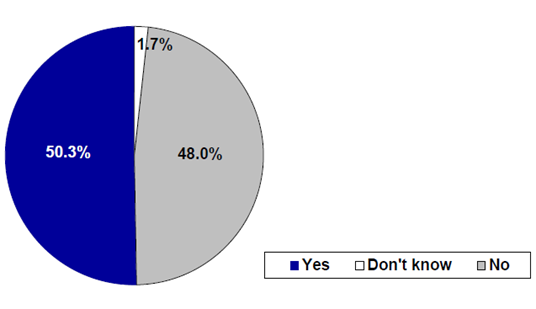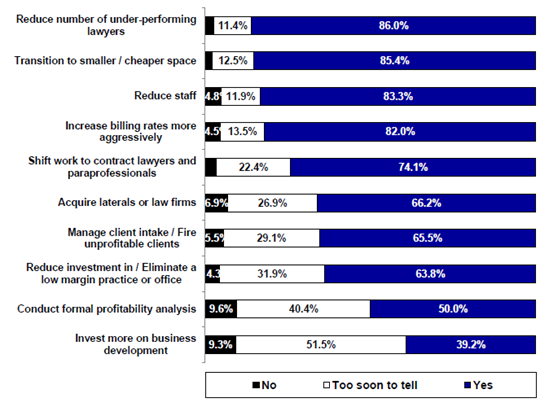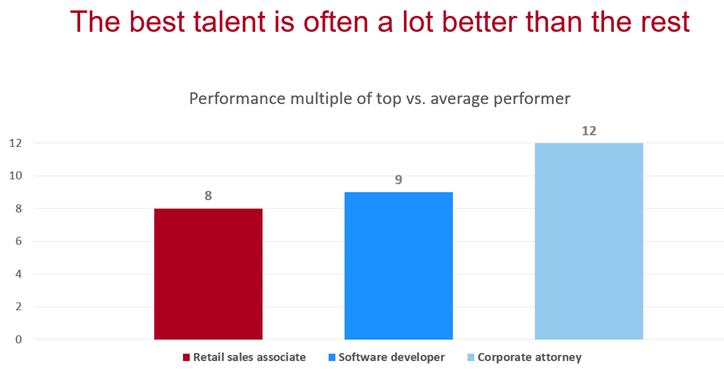The following column is by Janet Stanton, Partner, Adam Smith, Esq.
One of the most vexing issues for law firms is that of under-performing lawyers. And, let’s be clear from the get-go, we’re talking about chronic underperformance; not someone having, say, one bad year.[1]
Why is it necessary to address this issue? Quite simply, under-performers pose foundational risks to law firms; risks to both a law firm’s profitability and to its culture; damage to either can threaten a firm’s very existence. Moreover, this is an issue over which firms have complete control; unlike unexpected externalities. Importantly, there are significant upsides to dealing effectively with this issue; both financially and culturally.
I’ll talk about what firms can do about this issue later in this piece (and a hypothesis for why they find it so repellant to even think about). I’ll begin with the risks.
Let’s start with the financials
Both Thomson Reuters and Altman Weil provide compelling data sets on the danger under-performers represent to law firms.
From Thompson Reuters’s 2020 Law Firm Business Leaders Report
Risks to Law Firm Profitability
According to this survey, “under-performing lawyers” are said to represent the single highest risk to law firm profitability. Moreover, Thompson Reuters noted that in 2020 this factor is 9 pps. higher than what was reported in 2019. In fact, the only two elements on this list that firms can control are “under-performing lawyers” and “employee productivity.”
Certainly, the rough grouping of “late payments by client,” “downward pressure on fees from clients,” and “competition between law firms over fees” speaks to revenue insecurities at firms. We hear about these worries all the time; but underperformance? not so much. Why ignore the culprit in your own backyard?
Altman Weil in their 2020 Law Firms in Transition takes a different swing at the same issue.
Is overcapacity diluting your firm’s overall profitability?
They also note that the percent who answered “yes” is higher for larger firms (250 lawyers or more); 56.5%.
In the same study, the problem of under-performing lawyers is reported to be widespread.
Does your firm currently have any chronically under-performing lawyers?
Building on this, Altman Weil reports that,” in nearly a quarter of all law firms, more than 10% of lawyers are considered underperformers.” (emphasis mine)
Importantly, the same study provides hope for the firms who do address lawyer underperformance.
The question posed was: “For each of those things you’ve done to improve your firm’s profitability, has the action resulted in a significant improvement in profitability?” (emphasis theirs)
It is notable that among all these profit-enhancing tactics, reducing the number of underperforming lawyers topped the list. (NB: Post-pandemic, I expect “transition to smaller/cheaper space” may win out, however, easing out under-performers will remain near the top and with broader applicability to more law firms.)
To sum up, the solution to the single-highest risk factor to law firm profitability is the most effective tactic at actually improving profitability. And, the solution is entirely within the purview of each firm. Rarely are things this black and white.
There’s another (pretty obvious) reason not to dilute your partnership with under-performers; top performers are just better. Though we all know that instinctively, we (at least, I) generally had no clue know how much better top performers are. Fortunately, an analysis out of Bain demonstrates how much better “A” players are versus average performers. In the case of corporate lawyers, Bain found them to be 12 times better than average performers.[2] Imagine what the multiplier is versus under-performers. This from the Harvard Business Review:
The impact on firm culture
Let’s start with this from one of the savviest coaches in college football history.
“Excellence and mediocrity can’t be in the same place.”
— Nick Saban, Head Coach
‘Bama’s Crimson Tide
There are several problems with tolerating under-performers. Persistent under-performers can act as a millstone on the rest of the firm because, in fact, everyone at the firms knows who the under-performers are. Under-performers almost always know they are underperforming and may welcome the release of finding a more appropriate platform (we’ve seen this happen many, many times).
Moreover, ignoring under-performance sends the wrong message to the firm; implying that it is acceptable which may then encourage others to follow suit. This can lead to a slow, steady erosion of the firm’s culture; one that is imperceptible in the near-term, but over time can be devastating.
Doing something about it, on the other hand, sends an emphatically positive message to the firm, reinforcing the values and expectations of the firm and may serve as a deterrent to potential backsliders.
Why do firms find it so vexatious to address the issue of underperformance?
This boils down to two aspects that are distinctive to law firms: the partnership structure and that law firm management and decision-making is concentrated in the hands of fellow partners.
“Partnership” fosters the false, perhaps idealistic notion of “equality.”[3] This often translates to something along the lines of, ”It’s not within our culture to tell partners, really, what they can and can’t be doing.” Partners often find it unseemly to “act against” other partners. This is true even for those partners who have been chosen for managerial/leadership positions (MP, Exec Comm, etc.). North American law firms have been characterized as being “management lite” which suits most partners just fine.[4]
So, nothing happens.
What’s to be done?
Getting past institutional inertia is hard – but as we’ve seen is essential to thrive.
Since the recession of 2008-2009, there has been a clear trend among more successful firms (as defined by financial performance) to focus more intentionally on underperformance. This is part of the larger trend our research shows among these more successful firms; they are run in a more business-like manner which has broad implications for firms including intentionally and systematically reviewing and acting upon underperformance. While this trend was present before the 2008-2009 recession, it gained momentum as client pressures and competition heated up. We (and others) expect the “Covid-slingshot” effect will add more fuel to the fire and for firms to remain successful, they’ll need to be run and managed in an increasingly professional, intentional manner across many aspects at firms.
Partner expulsion is a very sensitive issue at law firms and not to be taken lightly. That said, it is necessary for firms to have a clear mechanism to remove those rare individuals who are serially deviating from the expectations for the performance of their partners.
This should be an evergreen part of a firm’s strategic planning process and/or included in the partnership agreement. Institutionalizing the process will make it a more accepted, if not entirely welcome, aspect of running a firm. Many firms rely on an informal process, handling each situation on an ad hoc basis which can get really ugly.
Importantly, while the process should be well-defined, it must be undertaken with as much grace and humanity as possible. Respect is due every individual and certainly to those who have contributed to the firm often over many years.
Before it gets to this point, if a partner is, say, seeming to flail, the firm should seek formal and informal ways to intervene. Find out if there are obstacles that can be cleared. Could personal coaching help? Help the individual find a more fitting platform. How under-performers are treated will speak volumes to the rest of the firm.
But, as we all know, the mere existence of any expulsion mechanism may trigger lawyerly skepticism. Confirmed in quantitative testing, lawyer psychology skews towards skepticism and worry.[5] Firm management should do their best to countervail these tendencies. In order to minimize concerns among individual partners at the firm that this may be about “them,” it is incumbent upon the firm to clarify (a) why this mechanism is a necessary protection for the overall sustainability of the firm and (b) the significance of the deviation from the norm that would call for expulsion. Communication is critical here.
A quick aside on what does not work. Do not assume you can persuade under-performers to up their game or leave simply by cutting their comp, even drastically. For some the reduced comp is a tradeoff they’re willing to make for a lighter workload. Not only does reducing comp not work, it is, frankly, cowardly; often leaving the individual in a frustrating no-man’s land and the firm still saddled with someone not pulling their weight and setting a harmful example. There are times when management must step in.[6]
To close, we think this is an entirely optimistic message for firms: There is a clearly-identified, consequential and prevalent threat to firms that, unlike fee pressure or other exogenous factors, is entirely within your control to solve.
We’ve worked with firms who have institutionalized systematic approaches to monitor performance including remediation programs and, if necessary, protocols and timelines to graciously move persistent under-performers to more suitable placements. This plus other, more business-like initiatives has resulted in significantly improved financial performance (both revenue and profit) as well as higher caliber partnerships, more upmarket work, more stable, cohesive and energized firms. All good things.
_______________
[1] We’re also not talking about bad actors; who are just toxic. You know who they are – those with big books (why else would they be tolerated for years?) – who flout the rules, treat associates and staff shabbily (or worse), and make everyone else feel like jerks. They should also be excised from the firm (though with planning and foresight in order to maintain as much of their book as possible). Once they’re actually gone, the entire firm will breathe a collective sigh of relief. We’ve seen this happen more than once.
[2] We can certainly quibble if the number is 12x or some other x – but clearly there is a significant differential.
[3] This notion of “equality” though is instantly belied by the often-wide spread in partner comp.
[4] As a gross generalization UK-based firms, which tend to be more business-oriented than US-based firms, have been (quietly) dealing with the issue of underperformance for years.
[5] Quantitative studies among thousands of lawyers conducted by Dr. Larry Richard using the Caliper Profile tool among others (https://www.lawyerbrain.com/about-dr-larry-richard)
[6] From personal experience, dealing with under-performers can be agonizing. That said, leaders need to suck it up and act in the best interests of the firm; that is their overriding responsibility. Corporations, though far from perfect, regularly assess, and act upon underperformance.







